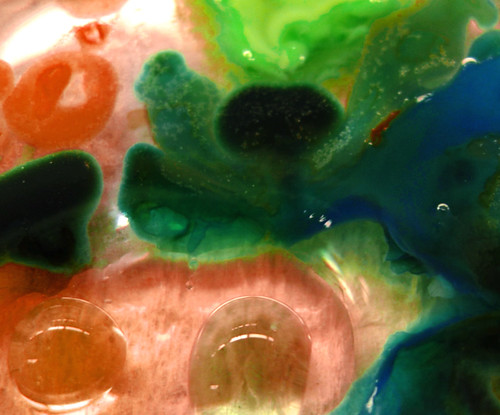
Circus Colors of Chemistry.
What happens when aqueous sulfate salts of cobalt, nickel and copper mix together?
Solids of flamboyant colors separate into riotous domains and boundaries that only nature can conceive.
Photo courtesy of chemistry graduate student, Jack Hess.
Click image for a larger version in its own window.
I discovered this stunning photo at Flickr's Laboratory Photo Pool. (I also store my photos at Flickr). I wrote to Jack Hess, the (currently blogless) photographer, seeking permission to use this photo here, and I received a gracious reply from him within 20 minutes. I share portions of that email here. Jack writes;
I am a chemist by training; a teacher at heart; and a self-confessed inveterate blogophile. I am about to finish my Ph.D. in Electrochemical Surface Science from TAMU. My Master's degree in Chemistry has allowed me to dabble in chromatographic extractions and bioactivity testing of tropical red algae. Dr. Mengele would have been proud with my intracranial mouse bioassays. I had been a lecturer of Physical Chemistry for seven years before I embraced a starving-yet-frenetic lifestyle of a struggling graduate student.
So, dear readers, you tell me; which color is each element in that photograph?
Update: which elements change color based on their oxidation state? Can you name the color and corresponding oxidation state?

I'm not going to guess about the identities of each color (Inorganic seems like soooo long ago...), but I do like how that looks so much like the microbial mats I used to study. *nerdy drool*
The green should be copper and the blue cobalt, which would likely make the orange nickel.
you were so quick, Max, that i added several more questions. perhaps you know the answers to those, too?
Aqueous Co+2 is pink to red/brown depending upon concentration. Aqueous Ni+2 is green (with a hint of blue). Aqueous Cu+2 is blue. Sulfates, with the exception of Ba+2, Ca+2, Pb+2, and Hg+, are all highly soluble so no precipitates would form.
out of this world. gorgeous.
My god, chemistry is so '70s! Who knew?